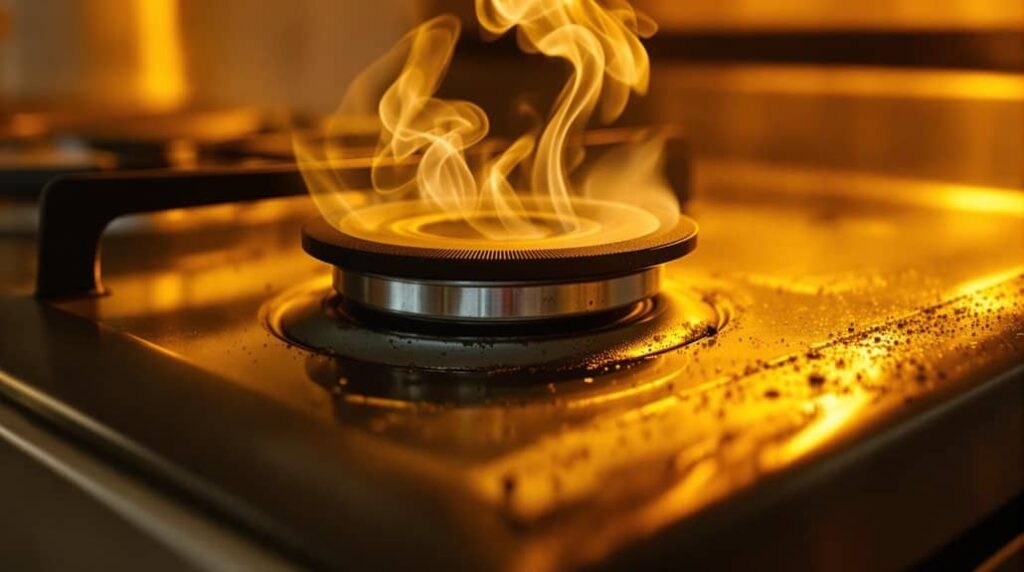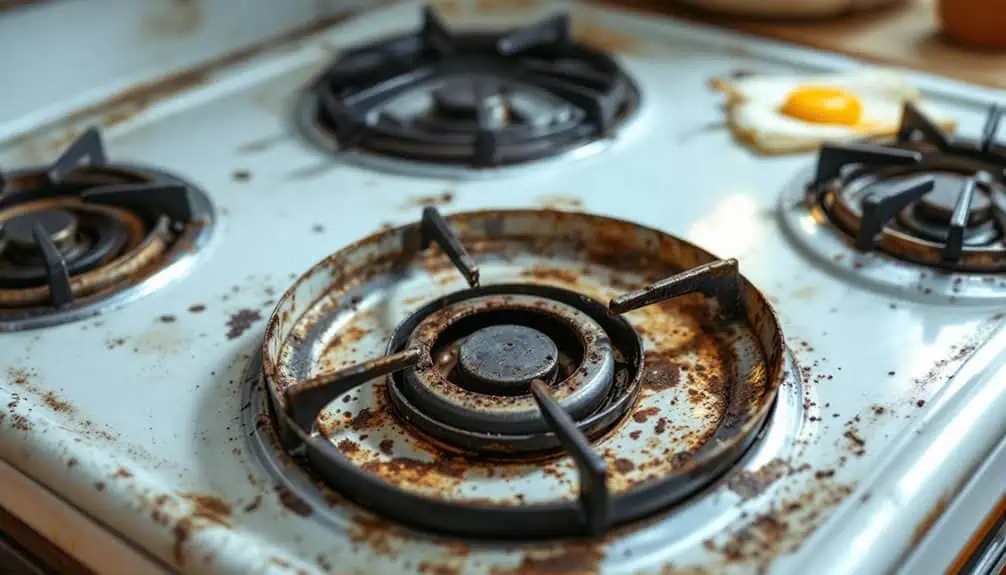If your stove smells like burning plastic, identify and address the source immediately, as it can be a sign of a serious issue, ranging from a simple cleaning problem to a potentially hazardous electrical fault. Check for debris, such as plastic items left in the oven, and inspect hidden areas like the oven cavity, back, and racks. Verify proper ventilation, remove any visible debris, and clean the affected areas promptly. If the smell persists, it may indicate a deeper issue, such as faulty electrical wiring or overheating components, which require prompt attention to prevent risks, and there are steps you can take to resolve the issue and prevent future occurrences.
Key Takeaways: Quick Solutions for a Safe Stove
Quick Steps to Eliminate Stove’s Burning Plastic Smell:
- Locate the problem quickly: Check oven cavity and racks for melted items or residue to prevent lasting damage and costly repairs.
- Take immediate action: Remove debris and wipe surfaces clean – a 10-minute task that will save hours of deep cleaning later.
- Natural odour elimination: Sprinkle baking soda on affected areas and spray vinegar solution for a chemical-free fix that works within hours.
- Safety first inspection: Look for signs of electrical issues or hot spots – early detection prevents expensive repairs and ensures kitchen safety.
- Simple maintenance routine: Monthly cleaning prevents odours and extends appliance life, saving money on repairs and replacements.
Each step focuses on practical, time-saving solutions that keep your kitchen functional and safe. These straightforward fixes help maintain your appliance’s performance while preventing more serious issues down the line.
Note: If a burning smell persists after trying these solutions, contact a qualified technician for a professional inspection.
Common Causes of Burning Plastic Smells in Stoves

When you turn on your stove and are hit with the unmistakable smell of burning plastic, your first instinct is likely to panic. However, recognizing the common causes of oven odours is the first step to resolving the issue and maintaining your appliance effectively. You see, new ovens often emit a burning smell due to manufacturing residues, which typically disappear after 2-3 uses. Additionally, plastic items left in the oven, faulty electrical wiring, or overheating components can also cause a burning plastic smell. Chemical cleaners were not suitable for oven use or burnt food residues can also contribute to the odour. The burning smell could be a sign of an electrical issue that needs to be addressed immediately to prevent accidents. Understanding these common causes empowers you to tackle appliance maintenance with confidence and fix the issue efficiently to continue serving others without interruption.
Immediate Actions to Take If Your Stove Smells
Upon noticing the burning plastic smell coming from your stove, take immediate action to guarantee your safety and potentially resolve the issue quickly. Perform an initial inspection to identify the source of the smell. Check for debris, such as leftover packaging materials, zip ties, or protective coatings, and remove them promptly.
| Hidden Areas to Check | Potential Debris | Action to Take |
|---|---|---|
| Oven cavity | Packaging materials, zip ties | Remove and dispose |
| Back of oven | Overlooked debris | Remove and clean |
| Racks and shelves | Plastic or packaging materials | Remove and wash |
| Oven floor | Food residue and debris | Clean and dispose |
| Ventilation hood | Grease and particles | Clean and maintain |
Ensure proper ventilation by opening windows and doors, and using the ventilation hood and exhaust fans to dissipate the odour. It’s essential to address potential fire hazards promptly to prevent further damage or risks.
Critical Electrical and Safety Checks Needed for Burning Smells
You’ve cleaned your oven, but if it still smells like burning plastic, it’s time to check for electrical issues. Start by turning off the power to the oven and nearby areas to prevent any further damage or fire risk, then unplug all devices to locate the source of the smell. Next, inspect your electrical fixtures and wiring for any visible signs of melting, damage, or wear that could be causing the smell.
How to Identify Electrical Issues in Your Stove
Identifying electrical issues in your stove is a matter of pinpointing the source of the problem. Effective appliance troubleshooting requires a thorough wiring inspection, starting with overloaded or faulty wiring systems. Be on the lookout for abnormal warmth, discoloration, or unusual odours around outlets and switches. A voltage tester is used to detect any issues with the voltage supply, checking for readings outside the 110-130 volt range. If you notice any electrical burning smells coming from the stove, immediately unplug it and investigate. Inspect the burner socket or switch for faulty connections and check the infinite control switch for any signs of damage. A detailed examination will help you identify the root cause and take the necessary steps to resolve the issue.
Comprehensive Safety Inspection Checklist for Your Stove
A thorough safety inspection is the next step in resolving the burning plastic smell from your stove. Start with an outlet inspection: check for abnormal warmth, discoloration, or odours around outlets and switches, and verify that plugs fit snugly into outlets. Use a block tester to determine outlet safety. Next, inspect the oven’s heating elements for food residue, grease, or oven cleaner buildup. Clean them with warm soapy water if necessary. Confirm all protective coatings are fully burned off in new ovens. Regular oven maintenance is vital, so clean the oven regularly to avoid heavy grease buildup. Adjust cooking time to prevent excessive burning of food and use heat-resistant cookware to avoid burning smells. By following these steps, you’ll be able to identify and address potential safety hazards and eliminate the burning plastic smell.
Top Tips to Prevent Burning Plastic Smells in the Future

Now that you’ve fixed your stove, it is crucial to take proactive steps to prevent future burning smells. By performing regular appliance check-ups and using proper cleaning techniques, you’ll greatly reduce the risk of unwanted odours. Additionally, following safe usage guidelines will help you avoid common mistakes that can lead to burning smells, such as overheating or neglecting to clean the oven’s heating elements.
Why Regular Appliance Check-Ups Matter
Maintaining your appliances through regular check-ups is essential to preventing future burning smells and ensuring they run efficiently. By performing routine inspections, you can identify and address issues before they become major problems, ultimately extending appliance longevity. To stay on track, create a schedule that includes tasks such as cleaning condenser coils, inspecting the stove for wear or damage, and checking plumbing connections for leaks.
| Appliance Component | Recommended Maintenance Frequency |
|---|---|
| Oven Interior | Clean and inspect 2-3 times a year |
| Burners | Check for proper operation monthly |
| Condenser Coils | Clean regularly to prevent cooling issues |
| Dishwasher Filter and Drain Hose | Clear after each use to prevent clogging |
Proper Cleaning Techniques to Keep Your Stove Safe
While a thorough inspection of your stove helps identify potential issues that might lead to burning smells, prevention through proper cleaning techniques is key to avoiding future problems. You’ll want to focus on cleaning frequency and the right cleaning products to get the job done. Regularly wiping up spills with mild soap and water prevents grime buildup, while a paste of baking soda and water tackles sticky spills. Don’t forget to line the bottom of your oven with aluminum foil or a silicone liner to catch drips. For tougher messes, use a commercial oven cleaner or a natural alternative like baking soda and vinegar. By maintaining a regular cleaning schedule and using effective cleaning products, you can prevent residue buildup and burning smells.
Essential Safe Usage Guidelines for Your Stove
By adopting safe usage guidelines, you can considerably reduce the likelihood of your stove emitting a burning plastic smell in the future. Proper oven usage and appliance safety are key to preventing these unpleasant odours. Before using your oven, verify all packaging materials, protective coatings, and plastic or zip ties are removed. Regularly inspect your oven’s wiring for wear or damage and keep electrical outlets from being overloaded. Maintain good ventilation in your kitchen, especially during the initial burn-in period, by opening windows and using exhaust fans. Schedule regular maintenance, including cleaning out appliances and switching out air filters, to prevent buildup and odours. By following these guidelines, you can verify a safe and odour-free cooking environment for yourself and others.
How to Eliminate Lingering Odours From Your Stove
Eliminating lingering odours fast requires some know-how and elbow grease. You can use natural absorbents like baking soda to effectively eliminate the smell of burning plastic. Place 1/2 cup of baking soda in small mason jars with holes in the lids around the kitchen. For tougher odours, mix baking soda with water to create a paste and apply it to the affected area. Vinegar solutions can also help, as they purify the air and absorb the odour. Create a solution of equal parts warm water and distilled white vinegar to clean burnt-on plastic residue. By utilizing these natural ingredients and techniques, you’ll be able to remove the smell of burning plastic from your stove and kitchen quickly and efficiently. This helps create a more welcoming environment for others.
Importance of Regular Maintenance for Stove Safety

As you focus on removing the smell of burning plastic from your stove, it is essential to recognize that regular maintenance plays a critical role in preventing such issues from arising in the future. By prioritizing maintenance, you can access numerous benefits, including improved appliance longevity, reduced energy waste, and enhanced overall performance. Regular cleaning, inspections, and tune-ups help prevent the buildup of bacteria, food particles, and grease, which can cause temperature fluctuations and other problems. Additionally, maintenance checks can identify potential issues, such as cracks in the oven gasket or malfunctioning temperature sensors, allowing you to address them promptly. By investing time in maintenance, you can greatly extend the lifespan of your stove, ensuring it continues to serve you and your loved ones safely and efficiently.
Safety Precautions Every Stove Owner Should Know
Your safety is paramount when tackling any repairs or maintenance work on your stove. Always wear the proper attire, including gloves, safety goggles, and sturdy footwear to minimize the risk of injury. Ascertain your clothing covers your skin to prevent cuts, burns, or exposure to harmful substances. Before starting work, disconnect the power supply to prevent electric shock, and switch off the circuit breaker if your stove is hardwired. Eliminate distractions by avoiding substances that could alter your mental state and keeping the area clutter-free. This allows you to focus on the task at hand and reduces the likelihood of accidents. By prioritizing your safety and taking these precautions, you can ascertain a successful and hazard-free repair or maintenance process.









